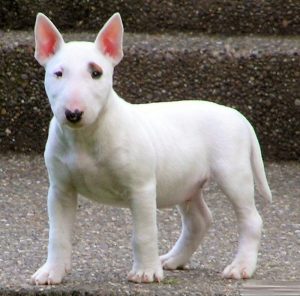Basic information about Bull Terrier Dogs
Bull Terriers are a unique and distinctive breed known for their muscular build, egg-shaped head, and playful personality. Here’s an overview of Bull Terrier dogs:
Appearance
Bull Terriers are medium-sized dogs with a robust and muscular build. They typically stand between 21 to 22 inches (53 to 56 cm) tall at the shoulder and weigh between 50 to 70 pounds (23 to 32 kg).
One of the most recognizable features of the Bull Terrier is their distinctive egg-shaped head, which is almost flat on top and slopes down to a strong, muscular neck. They have small, triangular-shaped eyes that are set obliquely and appear to glint with mischievousness.
Bull Terriers have a short, dense coat that comes in various colors, including white, brindle, fawn, red, black, or a combination of these colors. They may also have markings or patches on their coat.
Temperament
Bull Terriers are known for their playful, outgoing, and sometimes clownish personality. They are energetic and spirited dogs that enjoy being the center of attention.
Despite their muscular appearance, Bull Terriers are affectionate and loving with their families. They form strong bonds with their human companions and thrive on companionship and interaction.
Bull Terriers have a strong prey drive and may be prone to chasing small animals. Early socialization and training are essential to teach them appropriate behaviors and ensure they get along well with other pets.
While Bull Terriers can be independent and stubborn at times, they are also intelligent and respond well to positive reinforcement training methods.
History
The Bull Terrier breed originated in England in the 19th century, where it was developed through crosses between Bulldogs and various terrier breeds. The goal was to create a dog that combined the strength and tenacity of Bulldogs with the agility and gameness of terriers.
Bull Terriers were initially bred for bull-baiting and later for ratting and dogfighting. However, these cruel practices were eventually outlawed, and Bull Terriers were selectively bred for temperament and companionship.
The modern Bull Terrier breed was refined in the late 19th and early 20th centuries, with a focus on breeding for a more stable and sociable temperament. They were recognized by kennel clubs, including the American Kennel Club (AKC), in the late 1800s.

Training
Bull Terriers are intelligent dogs but can also be strong-willed and independent, which may present challenges during training. Consistent, positive reinforcement training methods that include praise, rewards, and clear communication are most effective with this breed.
It’s important to establish leadership and set boundaries early on to prevent behavioral problems and ensure that Bull Terriers understand what is expected of them.
Care
Bull Terriers have moderate grooming needs. Their short, smooth coat requires regular brushing to remove loose hair and maintain skin health. They may also benefit from occasional baths to keep them clean and smelling fresh.
Like all dogs, Bull Terriers require regular exercise to keep them mentally and physically stimulated. Daily walks, playtime, and interactive toys are essential to prevent boredom and destructive behaviors.
Bull Terriers are generally healthy dogs, but they may be prone to certain health issues, including deafness, heart problems, and skin allergies. Regular veterinary check-ups and a balanced diet are important for maintaining their overall health and wellbeing.

Overall, Bull Terriers are fun-loving and affectionate companions that bring joy and excitement to their families. With proper training, socialization, and care, they make excellent pets for individuals and families who appreciate their unique personality and appearance.
More posts you might be interested in:

